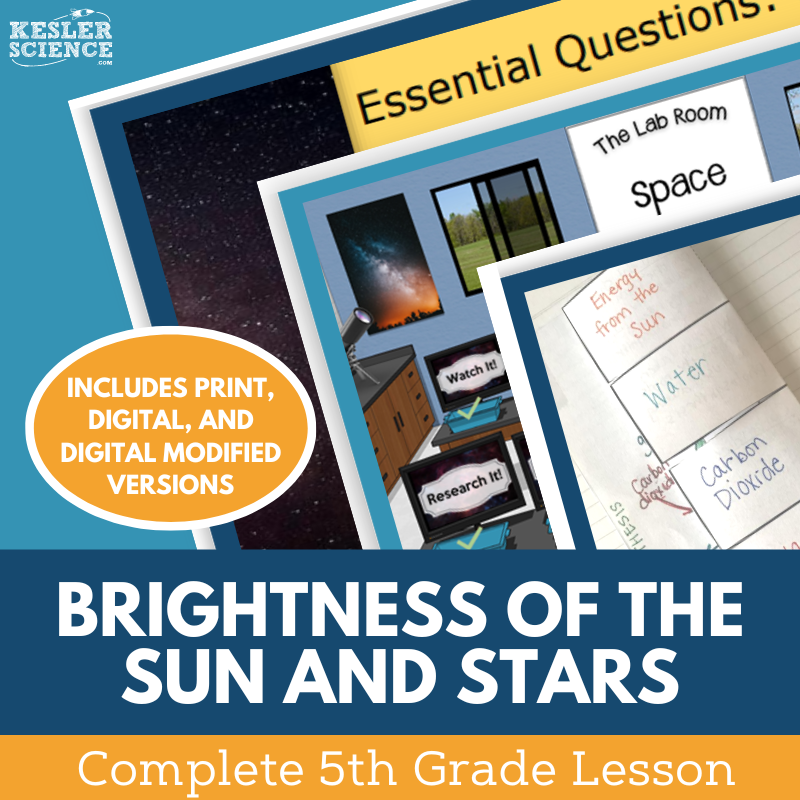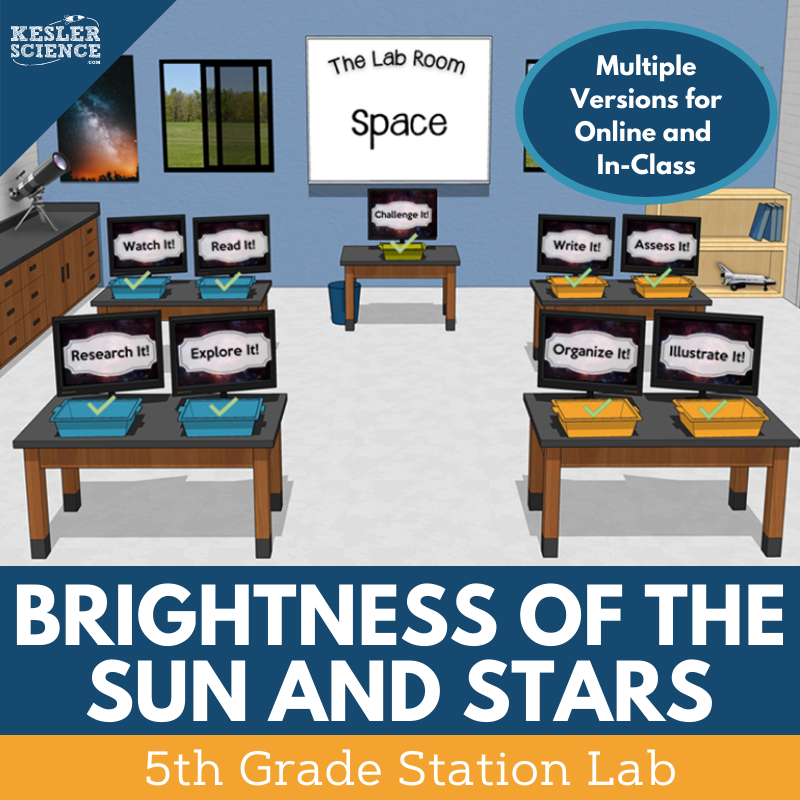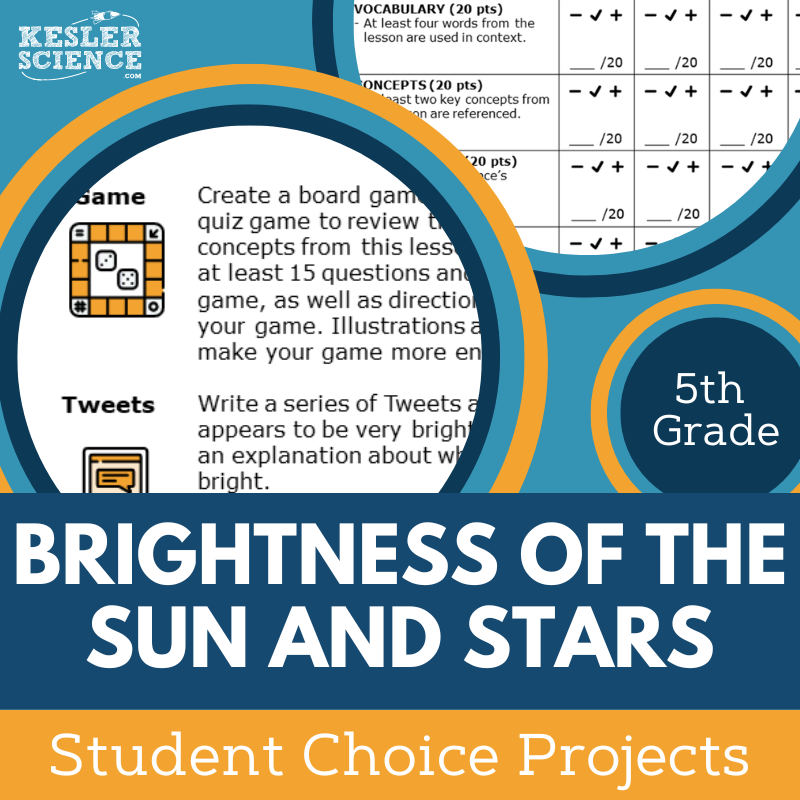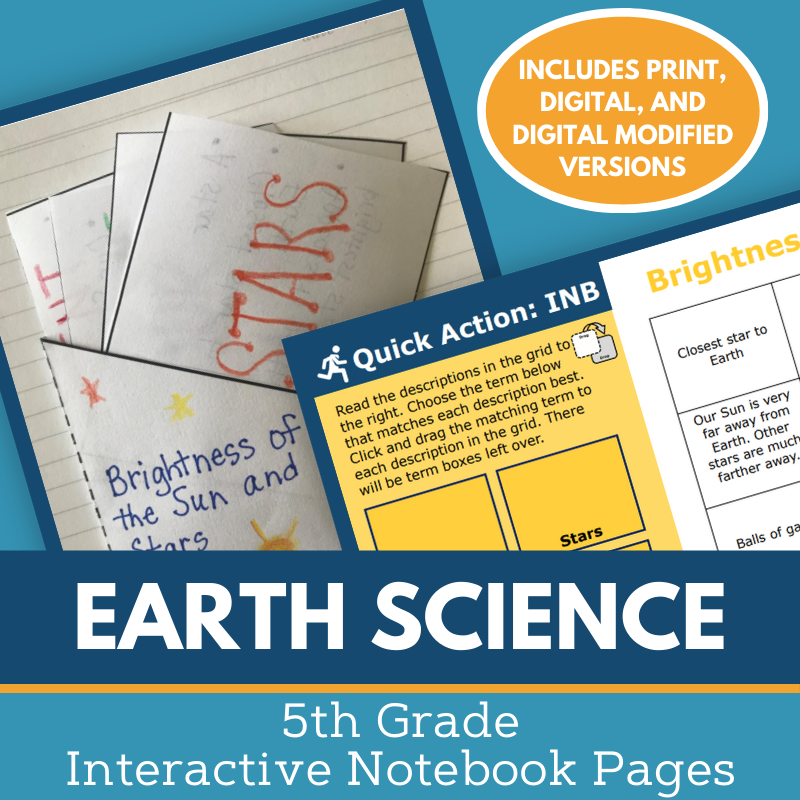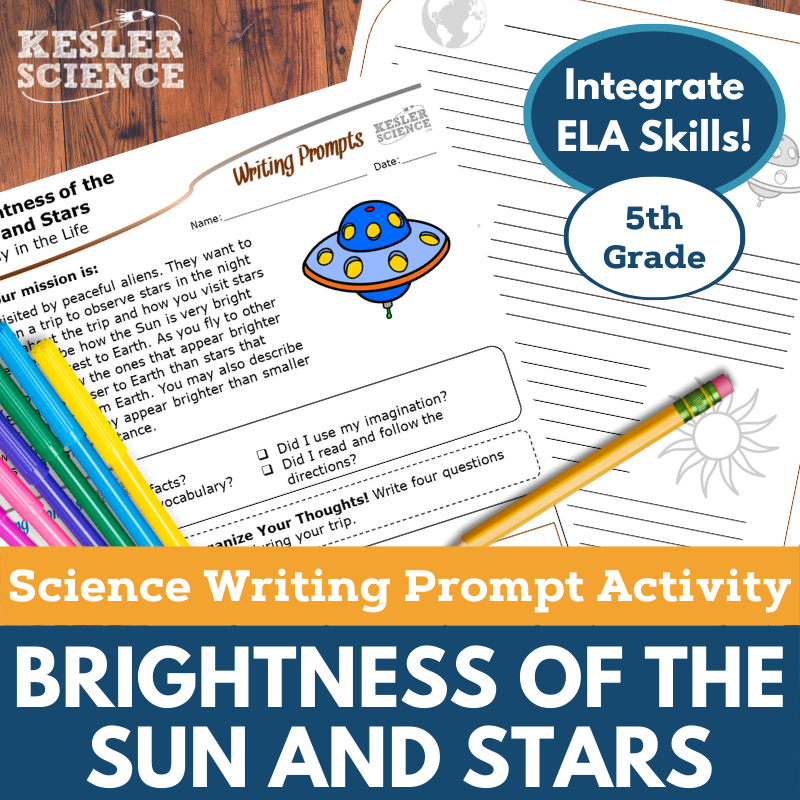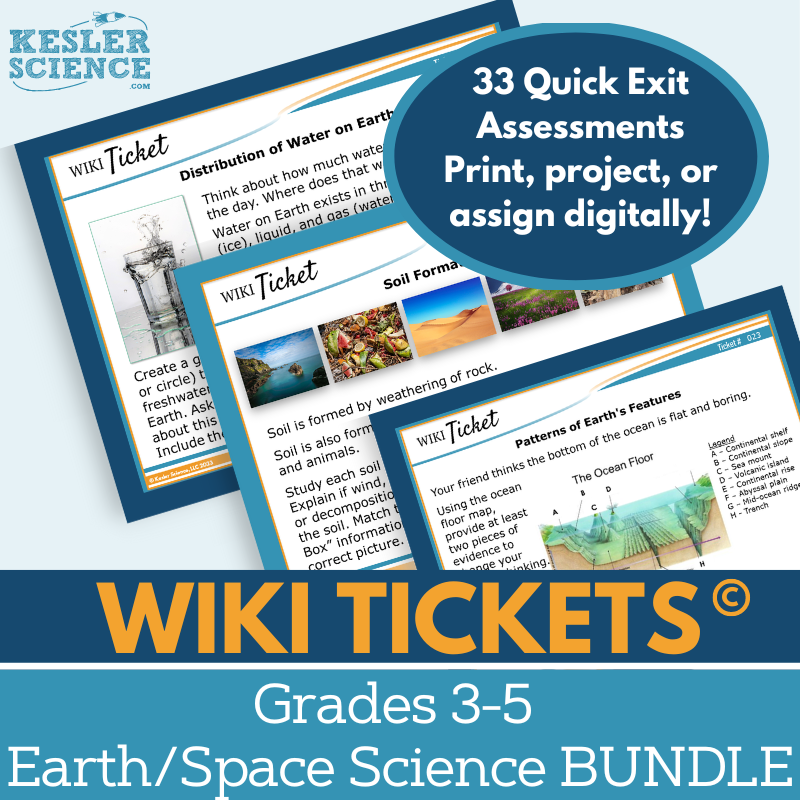Brightness of the Sun and Stars Activities for 5th Grade Science
The Kesler Science Brightness of the Sun and Stars resources provide engaging, student-led activities that explore why the Sun appears brightest and how distance affects a star’s brightness. The resources below will give students a comprehensive understanding of the brightness of the Sun and stars. All of the following materials are also included in the Kesler Science Membership.
The Kesler Science Brightness of the Sun and Stars 5th Grade Complete 5E Lesson provides everything needed for a multi-day, student-led exploration of space science. With minimal prep, teachers can focus on real student success while guiding learners through essential questions about why the Sun appears the brightest and how distance affects a star’s brightness. Differentiated materials, multimodal learning, and flexible print-and-digital formats ensure accessibility for all students.
Following the 5E Model, the lesson progresses through engagement, exploration, explanation, elaboration, and evaluation. Students begin with engaging discussions and vocabulary-building activities before diving into exploration stations, which provide hands-on experiments, reading passages, research tasks, and video-based learning. Output stations allow students to organize, write, illustrate, and assess their understanding, with a challenge station offering enrichment for early finishers.
Teachers can further customize learning with editable PowerPoints, interactive notebooks, and student-choice projects. Assessment options include differentiated quizzes, review questions, and worksheets for mastery checks. Whether in-person or virtual, this comprehensive lesson makes space science both engaging and meaningful.
The Kesler Science Brightness of the Sun and Stars 5th Grade Complete 5E Lesson provides everything needed for a multi-day, student-led exploration of space science. With minimal prep, teachers can focus on real student success while guiding learners through essential questions about why the Sun appears the brightest and how distance affects a star’s brightness. Differentiated materials, multimodal learning, and flexible print-and-digital formats ensure accessibility for all students.
Following the 5E Model, the lesson progresses through engagement, exploration, explanation, elaboration, and evaluation. Students begin with engaging discussions and vocabulary-building activities before diving into exploration stations, which provide hands-on experiments, reading passages, research tasks, and video-based learning. Output stations allow students to organize, write, illustrate, and assess their understanding, with a challenge station offering enrichment for early finishers.
Teachers can further customize learning with editable PowerPoints, interactive notebooks, and student-choice projects. Assessment options include differentiated quizzes, review questions, and worksheets for mastery checks. Whether in-person or virtual, this comprehensive lesson makes space science both engaging and meaningful.
Engage your classroom with this student-led station lab aligned with 5th grade science standards, where students explore the brightness of the Sun and other stars. Through differentiated, interactive stations, students learn to identify and compare the brightness of stars using models, multimedia, and hands-on tasks. This modular activity is designed for both in-class and virtual environments, requiring minimal prep while maximizing engagement.
The lab includes nine stations—eight core learning stations and one challenge station for early finishers. Students investigate new concepts through multimodal input stations, including videos, readings in English and Spanish, online research, and an experiment. Output stations let students show their learning by organizing data, illustrating models, writing responses, and completing assessments. This flexible format promotes active learning and student choice.
Resources come complete with signage, task cards, lab sheets, and materials compatible with PowerPoint and Google Slides. Whether students are manipulating images, conducting experiments, or engaging in creative mini-projects, this station lab offers a dynamic way to explore the brightness of celestial bodies while building science literacy.
Engage your classroom with this student-led station lab aligned with 5th grade science standards, where students explore the brightness of the Sun and other stars. Through differentiated, interactive stations, students learn to identify and compare the brightness of stars using models, multimedia, and hands-on tasks. This modular activity is designed for both in-class and virtual environments, requiring minimal prep while maximizing engagement.
The lab includes nine stations—eight core learning stations and one challenge station for early finishers. Students investigate new concepts through multimodal input stations, including videos, readings in English and Spanish, online research, and an experiment. Output stations let students show their learning by organizing data, illustrating models, writing responses, and completing assessments. This flexible format promotes active learning and student choice.
Resources come complete with signage, task cards, lab sheets, and materials compatible with PowerPoint and Google Slides. Whether students are manipulating images, conducting experiments, or engaging in creative mini-projects, this station lab offers a dynamic way to explore the brightness of celestial bodies while building science literacy.
The Kesler Science Brightness of the Sun and Stars Student Choice Projects empower 5th graders to showcase their understanding in a way that suits their learning style. With nine project options and a "design your own" choice, students take ownership of their learning while using creativity to demonstrate their knowledge. A clear rubric supports assessment by teachers, peers, or students themselves.
This flexible resource allows for easy modification to meet diverse learning needs. A differentiated version includes targeted support for students needing remediation, while advanced learners can be challenged with multi-project assignments. The editable rubric ensures consistency in evaluating vocabulary, concepts, presentation, clarity, and accuracy.
Designed for practicality, these projects utilize everyday classroom materials like paper, markers, and scissors, with digital options available for added versatility. Whether hands-on or tech-based, this engaging activity encourages personalized learning and meaningful exploration of the brightness of the Sun and stars.
The Kesler Science Brightness of the Sun and Stars Student Choice Projects empower 5th graders to showcase their understanding in a way that suits their learning style. With nine project options and a "design your own" choice, students take ownership of their learning while using creativity to demonstrate their knowledge. A clear rubric supports assessment by teachers, peers, or students themselves.
This flexible resource allows for easy modification to meet diverse learning needs. A differentiated version includes targeted support for students needing remediation, while advanced learners can be challenged with multi-project assignments. The editable rubric ensures consistency in evaluating vocabulary, concepts, presentation, clarity, and accuracy.
Designed for practicality, these projects utilize everyday classroom materials like paper, markers, and scissors, with digital options available for added versatility. Whether hands-on or tech-based, this engaging activity encourages personalized learning and meaningful exploration of the brightness of the Sun and stars.
The Kesler Science 5th Grade Earth Science Interactive Notebook bundle provides 11 essential topics with multiple templates, making science lessons more engaging and accessible. Designed for traditional, 1:1, and distance learning environments, this resource includes both print and digital formats to fit any classroom setting.
The digital version features unique interactive PowerPoint files, Google Slides compatibility, reflection pages, and modified templates for students needing accommodations. The paper version includes blank and pre-filled templates, plus color photo examples for easy implementation.
Covering key earth science topics like the water cycle, Earth's rotation, weather, and brightness of the Sun and stars, these interactive notebooks help students organize their learning while giving teachers an adaptable, low-prep resource.
The Kesler Science 5th Grade Earth Science Interactive Notebook bundle provides 11 essential topics with multiple templates, making science lessons more engaging and accessible. Designed for traditional, 1:1, and distance learning environments, this resource includes both print and digital formats to fit any classroom setting.
The digital version features unique interactive PowerPoint files, Google Slides compatibility, reflection pages, and modified templates for students needing accommodations. The paper version includes blank and pre-filled templates, plus color photo examples for easy implementation.
Covering key earth science topics like the water cycle, Earth's rotation, weather, and brightness of the Sun and stars, these interactive notebooks help students organize their learning while giving teachers an adaptable, low-prep resource.
The Kesler Science Brightness of the Sun and Stars Science and ELA Integrated Writing Activity helps 5th graders explore the closest star to Earth through a "day in the life" experience. This engaging activity strengthens science reasoning while encouraging students to develop their writing skills. It is designed for both in-person and virtual learning, ensuring flexibility and accessibility.
The activity includes teacher directions, projection and handout options, and a digital interactive version compatible with PowerPoint and Google Slides. Full-sized and half-sheet handouts provide structured support, including a writing prompt, self-check tools, and pre-writing strategies. Students can easily integrate their work into interactive notebooks or complete it digitally.
With its creative and low-prep design, this activity serves multiple purposes in the classroom. It can be used as a cross-curricular exercise, formative assessment, student choice project, or differentiation tool. Whether for early finishers, extra credit, or make-up work, it offers a meaningful way to connect science and writing.
The Kesler Science Brightness of the Sun and Stars Science and ELA Integrated Writing Activity helps 5th graders explore the closest star to Earth through a "day in the life" experience. This engaging activity strengthens science reasoning while encouraging students to develop their writing skills. It is designed for both in-person and virtual learning, ensuring flexibility and accessibility.
The activity includes teacher directions, projection and handout options, and a digital interactive version compatible with PowerPoint and Google Slides. Full-sized and half-sheet handouts provide structured support, including a writing prompt, self-check tools, and pre-writing strategies. Students can easily integrate their work into interactive notebooks or complete it digitally.
With its creative and low-prep design, this activity serves multiple purposes in the classroom. It can be used as a cross-curricular exercise, formative assessment, student choice project, or differentiation tool. Whether for early finishers, extra credit, or make-up work, it offers a meaningful way to connect science and writing.
The Kesler Science 5th Grade Earth/Space Science WIKI Tickets offer engaging, low-prep formative assessments to check student understanding. With 33 topics aligned to NGSS and TEKS, these exit tickets provide quick insights into learning while keeping students interested. Each ticket is designed to be colorful, interactive, and easy to implement in any upper elementary science classroom.
Each WIKI Ticket comes in five formats: a full-screen projection version, three printable handout sizes, and a digital interactive option for Google Slides or PowerPoint. This flexibility allows teachers to use them in various settings, whether in-person, remote, or hybrid learning. Students can respond on paper, digitally, or verbally, making these assessments accessible and adaptable.
Covering essential earth and space science topics like weather, natural resources, the water cycle, and planetary patterns, WIKI Tickets help reinforce key concepts. Whether used as exit tickets, bellringers, or quick progress checks, they provide valuable feedback to guide instruction while keeping students engaged.
The Kesler Science 5th Grade Earth/Space Science WIKI Tickets offer engaging, low-prep formative assessments to check student understanding. With 33 topics aligned to NGSS and TEKS, these exit tickets provide quick insights into learning while keeping students interested. Each ticket is designed to be colorful, interactive, and easy to implement in any upper elementary science classroom.
Each WIKI Ticket comes in five formats: a full-screen projection version, three printable handout sizes, and a digital interactive option for Google Slides or PowerPoint. This flexibility allows teachers to use them in various settings, whether in-person, remote, or hybrid learning. Students can respond on paper, digitally, or verbally, making these assessments accessible and adaptable.
Covering essential earth and space science topics like weather, natural resources, the water cycle, and planetary patterns, WIKI Tickets help reinforce key concepts. Whether used as exit tickets, bellringers, or quick progress checks, they provide valuable feedback to guide instruction while keeping students engaged.
Year-Round Resources
These year-round activities will increase your students' understanding of many middle school science topics. All of these activities are also included in the Kesler Science Membership.
Visual Data & Graphing
You're not alone if your students struggle with understanding graphs, charts, and tables. It's a skill that takes an enormous amount of practice. This resource will help students build a strong foundation in analyzing data and creating their own data visualizations.
Bell Ringers and Warm-Ups
These middle school science bell ringers are an excellent way to engage your students as soon as they walk into your classroom. This comprehensive FULL YEAR resource includes everything you need to start off each science class with an interesting warm-up activity.
Review Board Games
Each game board has been carefully designed to keep students engaged. There are 10 different action spaces on each board and dozens of question cards. All of the actions are related to science concepts and keep the students motivated throughout the game.
Each game is ready to play. Simply print out the board and the cards and let the students enjoy reviewing nine different units.
Essential Questions
Below are the essential questions associated with the lessons and activities included in this unit. This topic is only one of more than 100 middle school science topics included in the Kesler Science Membership.
-
How does the relative distance of a star affect how brightly it shines in Earth’s sky?
-
Why is the Sun the brightest star in Earth’s sky?
Kesler Science Membership
Imagine never having to search for another middle school science lesson again. The membership gives you access to ALL of the Kesler Science products in one place (Yes, including everything above).
Say goodbye to long hours of lesson prep.

